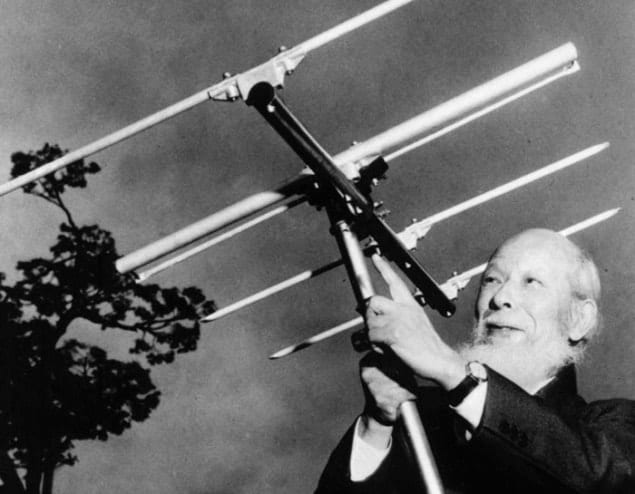
Researchers in Japan have built a nano-scale version of the classic antenna used to pick up TV signals in millions of homes around the world. The device, which is based on the “Yagi-Uda” antenna, could lead to novel sensors by manipulating the light emitted by individual molecules.
The Yagi-Uda antenna was invented by Japanese scientists in 1926 to overcome signal degradation, which can be a problem of radio signals degrading when transmitted over long distances. It was used by the British with radar during the Second World War and went on to become the standard antenna for transmitting and receiving television signals.
Key to the classic design is “parasitic elements”, made from strips of electrical conductors. These elements induce currents in the presence of a radio signal, which, in turn, generate secondary radio signals that can be transmitted in the same direction as the original signal. The same principle works in reverse so the antenna can boost a signal when receiving information.
Yutaka Kadoya and his colleagues at Hiroshima University have adapted the Yagi-Uda design to control light at the nano-scale by replacing the conducting strips with an array of five gold nanorods. The nanorods are aligned in such a way that incoming light manages to trigger plasmons in the gold surface – that is collective wavelike motions of billions of electrons – to resonate and emit secondary light in the same direction. The researchers demonstrate the technique for red light, which has a wavelength of 662 nm.
“The scale does not affect the phenomena due to the scaling principle in Maxwell’s equations – the reduction in size simply leads to a reduction of the relevant wavelength of the waves,” says Kadoya.
Geoffroy Lerosey, a materials scientist at the Institut Langevin – ESPCI, in France, is impressed that the researchers have been able to adapt a macro-scale design and apply it to the nano-scale. “Thinking about downscaling a system is not that hard,” he says. “But doing so and being able to experimentally demonstrate it is definitely much more complicated, given the difficulties that one experiences with nanostructures.”
The researchers believe that controlling light signals at this scale could lead to new sensors that couple to light-emitting particles, such as fluorescent molecules, which are already used for imaging and detecting in the health sciences. They intend to develop the research by seeking ways of integrating fluorescent molecules into their device.
This research is published in Nature Photonics.



